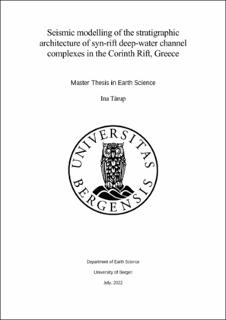| dc.description.abstract | Deep-water systems in rift basins lack extensive research because they tend to be buried in the subsurface making them hard to study directly. Rare, exhumed deep-water syn-rift depositional systems can therefore provide valuable insight into their stratigraphic architecture. Understanding the evolution, stratigraphic architecture and geometries of syn-rift deep-water deposits is valuable knowledge regarding energy resources, CO2 sequestration as well as understanding past climate, environmental and tectonic change. As syn-rift deep-water deposits in the subsurface are typically studied using seismic reflection data, generating synthetic seismic images based on outcrop analogues is a good way of gaining more knowledge about the detectability and imaging of such deposits. In this study, a 2D Point-Spread Function (PSF) based convolution modelling approach was applied to generate synthetic seismic images of syn-rift deep-water channel complexes in the Corinth Rift, based on geological models created from virtual outcrop models and cross-sections. The study further analyses the impact of variable geophysical parameters, such as the dominant frequency, maximum illumination angle, incident angle and level of noise. The resulting 2D seismic images revealed that stratigraphic architecture and rock body geometries can be detected at different scales dependent on the input parameters of the seismic modelling, and reflectivity is dependent on dominant lithologies and complexity of the stratigraphic architecture. The lateral and vertical resolution and seismic detectability is most impacted by dominant frequencies, illumination, and noise levels. The resultant synthetic seismic images simulating conventional seismic images showed that on a general basis, syn-rift deep-water channel complexes can be detected, but individual channel forms and stratigraphic architecture may fall under seismic resolution or only produce subtle amplitude variabilities and can therefore not always be resolved. | |
